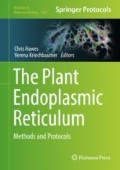Abstract
The plant endoplasmic reticulum (ER) forms several specialized structures. These include the sieve element reticulum (SER) and the desmotubule formed as the ER passes through plasmodesmata. Imaging both of these structures has been inhibited by the resolution limits of light microscopy and their relatively inaccessible locations, combined with the fragile nature of the ER. Here we describe methods to view desmotubules in live cells under 3D-structured illumination microscopy (3D-SIM) and methods to fix and prepare phloem tissue for both 3D-SIM and transmission electron microscopy (TEM) which preserve the fragile structure and allow the detailed imaging of the SER.
Access this chapter
Tax calculation will be finalised at checkout
Purchases are for personal use only
References
Abbe E (1873) Beiträge zur Theorie des Mikroskops und der mikroskopischen Wahrnehmung. Arkiv Mikroskop Anat 9:413–468
Wilson T (1995) The role of the pinhole in confocal imaging system. In: Pawley JB (ed) Biological confocal microscopy. Plenum Press, New York, pp 167–182
Gustafson MGL (2000) Surpassing the lateral resolution limit by a factor of two using structured illumination microscopy. J Microsc 198:82–87
Schermelleh L, Carlton PM, Haase S et al (2008) Subdiffraction multicolour imaging of the nuclear peripheray with 3D structured illumination microscopy. Science 320:1332–1336
Dobbie I, King E, Partion RM et al (2011) OMX: a new platform for multimodal, multi-channel wide-field imaging. Cold Spring Harb Protoc 8:899–909
Kner P, Chhun BB, Griffis ER et al (2009) Super-resolution video microscopy of live cells by structured illumination. Nat Methods 6:339–342
Fitzgibbon J, Bell K, King E, Oparka K (2010) Super-resolution imaging of plasmodesmata using 3-dimensional structured illumination microscopy. Plant Physiol 153:1453–1463
Bell K, Mitchell S, Paultre D, Posch M, Oparka K (2013) Correlative imaging of fluorescent proteins in resin-embedded plant material. Plant Physiol 161:1595–1603
Bell K, Oparka K (2015) Preparative methods for imaging plasmodesmata at super-resolution. Methods Mol Biol 1217:67–79
Bell K, Oparka K, Knox K (2016) Super-resolution imaging of live BY2 cells using 3D-structured illumination microscopy. Bioprotocol 6(1):e1697
Evert RF (1990) Dicotyledons. In: Behnke H-D, Sjolund RD (eds) Sieve elements: comparative structure, induction and development. Springer-Verlag, Berlin, pp 103–137
Nagata T, Nemoto Y, Hasezawa S (1992) Tobacco BY-2 cell line as the “HeLa” cell in the cell biology of higher plants. Int Rev Cytol 132:1–30
Overall RL, Blackman LM (1996) A model of the macro-molecular structure of plasmodesmata. Trends Plant Sci 1:307–331
Knox K, Wang P, Kriechbaumer V, Tilsner J, Frigerio L, Sparkes I, Hawes C, Oparka K (2015) Putting the squeeze on plasmodesmata: a role for reticulons in primary plasmodesmata formation. Plant Physiol 168:1563–1572
Maillet M (1968) Etude critique des fixations au tétraoxyde d'osmium-iodure. Bull Assoc Anat 79:233–394
Barlow PW, Hawes C, Horne JC (1984) Structure of amyloplasts and endoplasmic reticulum in the root caps of Lepidium sativum and Zea mays observed after selective membrane staining and by high-voltage electron microscopy. Planta 160:363–371
Knoblauch M, Peters WS (2010) Münch, morphology, microfluidics: our structural problem with the phloem. Plant Cell Environ 33:1439–1452
Hayat MA (1968) The principles and techniques of electron microscopy, vol 1. Van Nostt and Reinold Company, New York, NY
Author information
Authors and Affiliations
Corresponding author
Editor information
Editors and Affiliations
Rights and permissions
Copyright information
© 2018 Springer Science+Business Media LLC
About this protocol
Cite this protocol
Bell, K., Oparka, K., Knox, K. (2018). Preparation and Imaging of Specialized ER Using Super-Resolution and TEM Techniques. In: Hawes, C., Kriechbaumer, V. (eds) The Plant Endoplasmic Reticulum . Methods in Molecular Biology, vol 1691. Humana Press, New York, NY. https://doi.org/10.1007/978-1-4939-7389-7_4
Download citation
DOI: https://doi.org/10.1007/978-1-4939-7389-7_4
Published:
Publisher Name: Humana Press, New York, NY
Print ISBN: 978-1-4939-7388-0
Online ISBN: 978-1-4939-7389-7
eBook Packages: Springer Protocols

